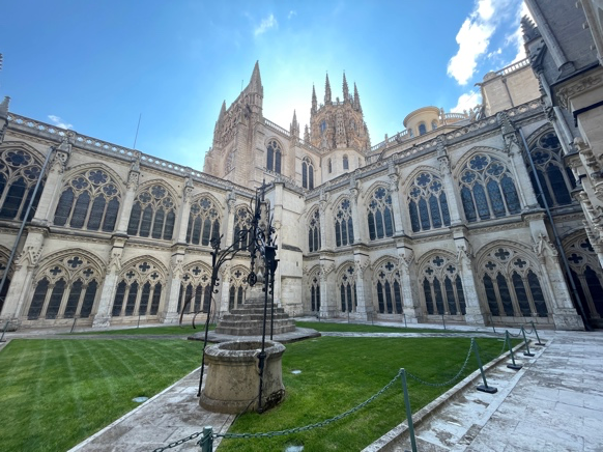Following in Chaucer's Footsteps through Historical Fiction
Travel and Culture Guest Author Series with Vancouver historical fiction author J.C. Corry
J.C. Corry’s first childhood memory was peering through rose-tinted stained glass in a Battersea church in London, England, colouring a passion for historical fiction emboldened by his father’s hole-ridden Normandy helmet that sits above his writing desk. An army brat, he lived in ten homes by the age of ten in Canada, England and Australia, studied literature (where his love for Chaucer began) and film, produced television documentaries about artists, and now leads a thriving corporate communications career in Vancouver, BC, where his two grown sons literally look down upon him. He loves travel, good wine, singing, dancing, live music, theatre and film, forest walks, and Scrabble.
The Storyteller's War: Geoffrey Chaucer, Reluctant Spy
March, 1366. Amid war-torn Spain, Geoffrey Chaucer—page to King Edward III and the son of a wine merchant—finds himself thrust into the heart of a conflict between two brothers: King Pedro the Cruel of Castile and his half-brother, Enrique Trastámara. But Chaucer's task is far from simple. Sent as a reluctant spy by the king, he must locate the elusive mercenary Sir Hugh Calveley and persuade him to change sides in a war that could alter the fate of kingdoms. If Chaucer fails, he not only risks losing his life and position but also the love of Pippa, the woman he cherishes. Surrounded by ruthless enemies, seductive spies, and looming battles, Chaucer must rely on his wit, charm, and storytelling to survive the assassin's blade and a seductress's schemes. As armies collide on the battlefield, Chaucer's greatest challenge becomes not just turning the tide of war-but winning the battle for Pippa's heart. Available May, 2025. See more at www.jccorry.com
T&C: Congratulations on your book launch, John! You visited a lot of countries while researching The Storyteller’s War. Outline the trip for us? Which one (or which areas) had the most influence on your book?
My goal with my research trip was to follow Chaucer’s footsteps in February 1366 when he travelled from London to Bordeaux to Navarre, Rioja and Castile (northern Spain) for my upcoming novel, The Storyteller’s War: Geoffrey Chaucer, Reluctant Spy.
I’ve done three research trips to Europe and always fly to London first. I lived there as a boy and it feels like a second home. I walked the streets of the Vintry district (between St. Paul’s Cathedral and the Tower of London) where Chaucer lived and imagined the London Chaucer would have seen. The Great Fire of 1666 wiped out much of medieval London, but the topography hasn’t changed dramatically (the Thames is narrower now). There is a historical marker where Three Cranes Wharf once stood, and where Chaucer’s father John would have unloaded barrels of wine off the cogs arriving from across Europe (he was deputy wine butler to King Edward the Third and placed Geoffrey at court).
I then flew to Bordeaux where Chaucer would have sailed next. At that time Bordeaux was controlled by the English under Prince Edward (now called the Black Prince). Only parts of medieval Bordeaux remain, but the topography of the crescent-shaped “Port of the Moon” is mostly unchanged. Two of the three huge buildings Chaucer would have seen, including the beautiful Cathédrale Saint-André, remain visible from the wharf on the river.
From Crow and Olsen’s Chaucer’s Life Records we know Chaucer was in Olite, Navarre on February 22, 1366. The record says he and his companions were given a three month pass from King Carlos to travel through Navarre. Marion Turner posits in her excellent Chaucer: A European Life that Chaucer, a lowly page, may have been there to spy on behalf of King Edward, two weeks before war boiled over, which became the genesis for my story. To get to Olite, Chaucer would have travelled over the Pyrenees during winter, a dangerous crossing. I took a bus across the Pyrenees in the summer and it was rainy and dangerous enough, and arrived in a Pamplona surrounded by mountains. The topography reinforced the idea that King Carlos had absolute control over the mountain passes. Olite Palace in Navarre, about 50 kms south of Pamplona, is one of the best preserved medieval castles in Europe. It would be difficult to attack, and the hanging gardens still exist to this day, which helped me write the scene where the gardens, filled then with exotic animals including lions and giraffes, made such an impression on Chaucer.
Burgos Cathedral, several city gates of Burgos, and nearby Los Huelgas Monastery are much as they were in 1366-7, which was so very helpful in envisioning King Pedro the Cruel’s escape from Burgos, and the crowning of Enrique. Here too were innumerable period details, like an incredibly beautiful wall hanging that portrayed the clothing of the day.
Navarette and Najera are also well preserved. It was clear standing in Navarette that if Prince Edward marched around a low mountain to the north of Navarette he could outflank Enrique’s army placed on the plain in front of Najera—as was posited by L. J. Andrew Villalon and Donald J. Kagay in their book To Win and Lose a Medieval Battle.
I drove to where Villalon and Kagay believe the Battle of Najera was fought, and it was so very helpful to see the long sloping valley that Enrique Trastamara would have faced, and the river and red cliffs behind that would negate any retreat.
T&C: You must have had a lot of memorable experiences along the way, for yourself and your book. Give us an example or two. What made it memorable for you? How did the experience change your perspective or affect your writing?
Staying overnight at Olite Palace was transformative. This was part of the chain of ‘parador” hotels run by the Spanish government in historically significant locations. It really gave me a sense of what a medieval lord or visitor would have experienced. The towers were tall, and insurmountable without huge siege engines. The walls were thick. The floor was cool in June and would have been cold in February; only some rooms had hearths for fires, and so much of the castle would have been cold.
Logrono is at a crossroads of the kingdoms of Castile to the west, Rioja to the south, Navarre to the north and Aragon to the east. Walking the streets helped me envision how strategically crucial the city was, as well as specific details like the brightly coloured window pots.
T&C: What did you see or experience of the local culture while you were travelling? Please describe a memorable example (or two). How was it new or different for you?
The Camino de Santiago in Spain runs from Pamplona to Burgos (and then on to Santiago de Compostela), an important pilgrimage then and now. I drove beside this ancient path and saw innumerable pilgrims walking, as they would have in 1366. In Puente La Reina, located between Pamplona and Logrono, a pilgrim hostel has stood since before Chaucer’s time. There I heard the sound of a single guitar and entered an ancient chapel where a lone guitarist played a medieval song. This was no tourist performance, just an artist sharing a timeless song, and I felt that I had just stepped back in time.
Bordeaux: The scene of Chaucer walking toward Cathédrale Saint-André was inspired by my own walk from the river to the cathedral.
Pamplona: Walking the cobblestoned streets inspired my description of Chaucer’s arrival and departure from Pamplona.
Los Huelgas: The crowning of Enrique Trastamara was written directly based on my visit to the chapel here. No photos were allowed so I had to go on memory of the space, including the huge Codex of Music written by the nuns that was propped on a stand, and the tombs of several kings and queens of Spain that lay along the middle of the chapel floor.
Burgos Cathedral: The first scene introducing King Pedro the Cruel where he kills his daughter’s suitor was written directly from my memory (and photos) of the well in the central cloister of Burgos Cathedral.
Olite Palace: The scene where Chaucer is shown the hanging gardens and lion at Olite Palace, and the meeting between Chaucer and King Carlos, were both derived directly from my visit there.
T&C: Did you try new foods or local dishes? What do you remember about your dining experiences?
Drinking pacharán in the middle of a calle in Pamplona. This reddish liquor is made from crushed and fermented sloes, the black-purple colored fruits from the blackthorn tree. It is an ancient local drink and would have been consumed in Chaucer’s time (I brought some home to continue my “research”), and is included in a scene.
Eating tapas amidst the bustle of a Logrono calle felt like a snapshot of a cultural experience that transcended time.
T&C: What would you tell someone else who wanted to travel there? What tips can you give us based on your experience?
Spend time walking the streets of the towns and cities you visit. I seldom join tours, just not my thing, and prefer to explore by car and on foot if possible. I enjoy striking up conversations with locals or visitors, and have found most of the good tips on things to see or places to visit through these conversations.
If you can afford to, invest in renting a car to explore the locations you want to see and take advantage of serendipitous moments. Have a rough plan and be open to changing plans if something interesting comes up.
Travel from Donostia-San Sebastian to Pamplona. At Donostia-San Sebastian you’ll find Basque culture prevalent, with Basque signs and delicious pinxtos (called tapas elsewhere in Spain).
If you’re taking photos and videos as part of research, try to organize by location and date as soon as you can. It can be easy to forget which city you were at (I was in 10 locations over 13 days).
T&C: Is there anything else you’d like to add about the experience or why it was memorable for you?
I recommend doing both online and in-person research, as the latter can provide colour and a sense of verisimilitude that no book or website can. Plus you have more stories to tell your friends, family and writing circle!
T&C: Thanks so much for detailing your research for us, and for all the great tips!
J.C. Corry is a historical novelist from Vancouver, BC (www.jccorry.com).
The Storyteller's War: Geoffrey Chaucer, Reluctant Spy (www.jccorry.com) is available for purchase on May 8, 2025.
Legal disclaimer: We disclaim all liability for the content of websites to which our site provides links.














How fascinating to follow in Chaucer's footsteps for the research. I had never heard of pacharán, and not sure I know what a sloe tastes like. Brings medieval history to life.